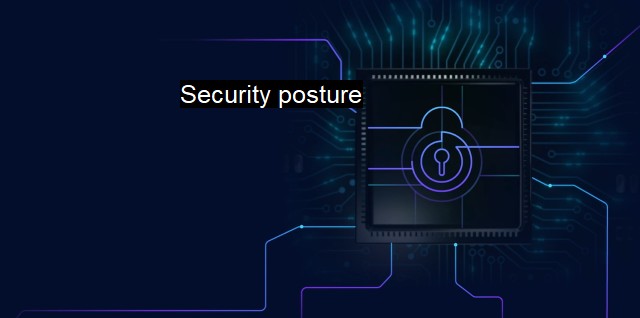What is Security posture?
Understanding the Importance of Security Posture in Cybersecurity and Antivirus Efforts: A Comprehensive Guide to Protecting Your Infrastructure
Security posture is a terminological concept most commonly used within the cybersecurity domain. It refers to an organization's overall cybersecurity strength and its capacities to predict, prevent, and respond to cyber threats. It encompasses all the security measures, controls, and policies an enterprise establishes to safeguard its network, data assets, and all necessary IT infrastructure from potential cyber threats, including viruses, ransomware, and other malicious digital endeavors.The fundamental elements that contribute to an organization's security posture include its people, processes, technology, controls, and enterprise-level policies. Specifically, 'people' refers to the workforce who manage cybersecurity measures and those who potentially pose internal security risks. 'Processes' are the practices and procedures that are adhered to for identifying, addressing, and preventing security vulnerabilities. The 'technology' aspect encompasses the hardware and software components which mitigate cyber risks.
Advanced 'controls' such as firewalls, antivirus software, encryption systems and other countermeasures are part of the actual methods applied to avert threats, and 'policies' are the rules set in place to deter and respond to these threats. A robust security posture banks on the seamless amalgamation of all these elements. Correspondingly obtaining a strong security posture is a continuous process heavily driven by the evolving extent and form of threats.
Conceptually, antivirus makes a key focus area in the context of security posture. It forms one part, albeit an essential one, of the wider technology element within a comprehensive cyber safety strategy. Antivirus software is used to detect, quarantine and eliminate viruses and other malicious software like Trojans, worms, spyware and more, thereby shielding the organizations' IT systems and networks from potential harm.
With the advancement in the fields of artificial intelligence and machine learning, viruses and malware are getting more shrewd and are able to defeat these antivirus protections. Therefore, a firm's antivirus approached must be persistently updated and evolved expressly with the latest technologies to ensure comprehensively secure defense lines.
A strong security posture should also affirm robust defenses against phishing, ransomware, and other advanced persistent threats, which typically evade traditional antivirus solutions. Thus, while antivirus coverage forms the building block of a security posture, the scope goes beyond to encompass the comprehensive gamut of cyber threats.
A Coronavirus analogy might help clarify this: if an organization's IT network is a human body, an antivirus is the flu vaccine—it's of paramount importance, but it cannot and does not protect against all health-related problems. This emphasizes the need to educate, implement effective additional control measures, and align people along with processes to identify and counteract any infringement.
Monitoring forms a critical component in comprehensively maintaining a strong security posture. Regular audits review and check the effectiveness of the existing security measures and help identify security weaknesses and the areas for improvement.
Security posture is a holistic view of the collective cybersecurity measures practiced by an organization. It is more encompassing than antivirus measures alone and signifies the current state of an organization's capability to protect its digital real estate from diverse threats. It provides a proactive approach to maintaining an updated, adaptive stance in the face of rapidly advancing cyber threats, thereby fortifying operations and assuring customer trust. Regular evaluation and enhancement efforts are required to optimize and strengthen the security posture, ultimately trimming down the likelihood and impact of a potential cyber breach.

Security posture FAQs
What is a security posture?
A security posture is the overall approach and strategy that an organization takes to manage and protect against cybersecurity risks. It includes policies, procedures, and technical controls that are put in place to identify, prevent, detect, and respond to potential threats.How does a strong security posture protect against antivirus threats?
A strong security posture can protect against antivirus threats by implementing multiple layers of defense, including network security, endpoint protection, and user education. This approach can help ensure that antivirus software is just one component of an overall security strategy, rather than relying on it as the sole defense against threats.What are some common elements of a strong security posture?
Common elements of a strong security posture include regular software updates and patching, multifactor authentication for access control, data encryption, continuous monitoring and threat assessment, and employee training in cybersecurity best practices.How can an organization improve its security posture?
An organization can improve its security posture by conducting regular security assessments to identify potential vulnerabilities, implementing security controls based on industry best practices and compliance regulations, establishing incident response plans that outline steps to mitigate security incidents, and regularly testing security controls to ensure they are effective. Additionally, investing in and utilizing effective cybersecurity tools and solutions can help to strengthen security posture.| | A | | | B | | | C | | | D | | | E | | | F | | | G | | | H | | | I | | | J | | | K | | | L | | | M | |
| | N | | | O | | | P | | | Q | | | R | | | S | | | T | | | U | | | V | | | W | | | X | | | Y | | | Z | |
| | 1 | | | 2 | | | 3 | | | 4 | | | 7 | | | 8 | | |||||||